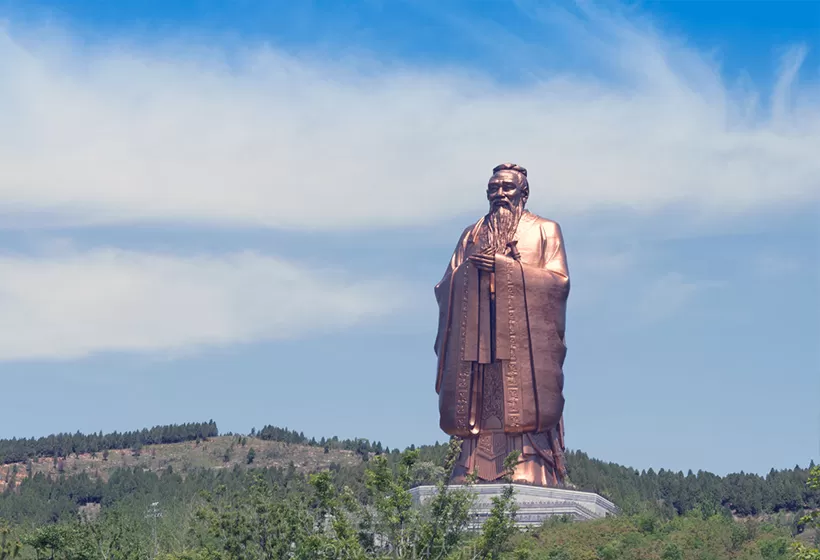Chinese Religious Belief
Taoism
It's generally believed that Taoism is a religion native to China. The Taoist School was established by Lao Tzu during the Spring and Autumn Period (about the 6th century BC). Later in the Warring States Period, there was an emergence of alchemists attempting to achieve immortality. Based on this, there was a boom of such Taoist schools like Fangxian (the immortality school) and Huanglao (huang in Chinese means "yellow", which refers to the Yellow Emperor, and lao refers to Lao Tzu) in the Qin and Han dynasties, both of which drew upon the concepts put forward by the Yin-Yang School, the Mohist School and the Confucian School. After years of development, the first organized form of Taoism, known as the Zhengyi School, was founded by Zhang Daoling in the Eastern Han Dynasty.
Buddhism
During the Yongping Period (58-75 AD), Emperor Mingdi of the Eastern Han Dynasty dispatched envoys to ancient India (known as Tianzu in Chinese) in search of Buddhist sutras. As a result, Buddhism was introduced from India to China. In the Wei, Jin, Southern and Northern dynasties, ordinary people started to search for spiritual comfort as a result of the social upheaval, resulting in the widespread acceptance of Buddhism. At that time Buddhism was influenced by the Metaphysical School and Confucianism was characterized by inclusiveness. Taoism and Buddhism drew upon the concepts upheld by Confucianism and became mutually reinforcing. Then the combination of these three religions (Confucianism, Buddhism and Taoism) gave rise to traditional religious belief in China.
Islam
Islam in China can be dated back to the time when Muhammad's uncle headed a mission to China and built the Huaisheng Mosque (the Saint Cherishing Mosque), one of the oldest mosques in the world. During the Song Dynasty, Chinese Muslims monopolized foreign trade and gradually became a force to be reckoned with at court. Celebrated Muslims include Zheng He and Yeheidie'erding, who was the chief architect in designing and constructing the city of Hanbali (today's Beijing). During the Ming Dynasty, descendants of the early migrant Muslims were assimilated into Chinese society, which was exemplified by their language, family names and customs. Nanjing was an important hub for Islamic teaching. Muslims in China are mainly the Hui, Uygur, Kazak, Kirgiz, Tatar, Uzbek, Tajik, Dongxiang, Salar and Baoan ethnic groups.
Christianity
Christianity in China enjoyed a long history. Nestorianism, a school of Christianity, was introduced into China in the Tang Dynasty. In the Yuan and Ming dynasties, Catholicism was introduced into China together with Western technologies. These religions were then localized so as to be commensurate with the society dominated by Confucianism. In the Qing Dynasty, the Qing government imposed a restriction on Catholic activities in China during the reign of Emperor Yongzheng in that because the Pope banned the Catholics in China from offering sacrifices to their ancestors. In 1840, the gunboats of Western aggressors forced China to open its door to the outside world. The following years witnessed a deluge of missionaries in China, who established a number of educational and medical institutes in the late Qing Dynasty and the Republic of China.
Other Religions
After the founding of the P.R.C in 1949, China's Constitution stipulates that citizens of the People's Republic of China enjoy freedom of religious belief. However, as a consequence of the Cultural Revolution in the 1970's, religious undertakings were still seriously ravaged. It was not until the introduction of the reform and opening-up policy in 1978 that the situation improved in this regard. In the mainland, religious beliefs were restored over time, though the overwhelming majority of the people claimed to be atheists. Today, Chinese people mainly worship Confucianism, Taoism, Buddhism, their ancestors and other religions. In addition, Islam, Christianity, Catholicism, Protestantism and the Orthodox Eastern Church also have their presence in China. Locally, there is Shamanism, Dongba Religion and animism. Buddhists mainly include the Tibetan (followers of Tibetan Buddhism), Mongolian, Luoba, Menba, Tu, Yugu, Dai (followers of Theravada Buddhism), Bulang, Deang ethnic groups and the Chinese Han people (followers of Chinese Buddhism).
GREAT FAMILY CHINA TOUR
JULY 2024 We wanted to thank Grace at China Culture tour for organizing a great tour of China. We enjoyed our Beijing - Xian-Chengdu -Guilin -Yangshuo - Shanghai trip. Our local guides Bruce in Beijing, Susan in Xian, Jane in Chengdu, Mike in Guilin and Mary in Shanghai took care of us…read more details »
Teng Han L from SINGAPORE
Ready to Create a Unique Dream Travel?

